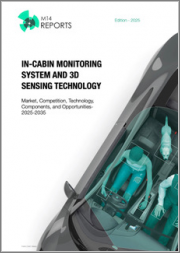
|
시장보고서
상품코드
1669756
세계의 인캐빈 모니터링 시스템(ICMS) 시장 : 기술, 시장, 기회, 경쟁(2025-2035년)Global In-cabin Monitoring System (ICMS): Technology, Market, Opportunities, Competition, 2025-2035 |
||||||
세계 자동차 산업에서는 경기 회복, 기술 진보, 소비자 선호의 진화로 2023년 이후 승용차 수요가 크게 회복되고 있습니다.
승용차 수요 증가
유행 후 자동차 부문은 강력한 회복을 보이며 주요 시장에서 승용차 매출이 급증하고 있습니다. 유럽에서는 2023년 승용차의 신차 매출이 1,500만대에 달하고, 전년대비 18.7%의 성장세를 기록했습니다. 이 급성장의 주인은 전기자동차(EV)의 보급과 정부의 인센티브입니다. 미국도 이에 이어 전년 대비 9% 증가한 약 310만대의 매출을 기록했습니다. 세계 최대의 자동차 시장인 중국은 도시화와 가처분소득 상승을 몰아치며 2023년 승용차 매출이 2,600만대를 넘어섰습니다. 일본과 인도도 소형차와 중형차 수요 증가에 힘입어 각각 400만대와 410만대의 매출을 기록해 성장을 보였습니다.
이 증가 추세는 2024년에도 계속되어 세계의 승용차 매출은 5%-7% 증가할 것으로 예측됩니다. 전기자동차와 하이브리드 자동차로의 이동과 자동차 기술의 발전으로 산업의 상황이 크게 바뀌고 있습니다.
승용차에서 ADAS 보급률의 배가
ADAS(선진운전지원시스템)는 안전성과 운전의 편리성을 향상시키는 현대 자동차의 요점이 되고 있습니다. 승용차에서 ADAS의 보급률은 지난 2년간 크게 증가하고 있습니다. 2023년 미국에서 판매되는 신차의 약 50%가 어댑티브 크루즈 컨트롤, 레인키프 어시스트, 자동 긴급 브레이크 등의 ADAS 기능을 탑재하고 있습니다. 유럽과 중국에서는 엄격한 안전 규제와 첨단 기능에 대한 소비자 수요에 힘입어 각각 55%, 60%와 더 높은 보급률이 보고되었습니다.
ADAS를 탑재한 자동차의 매출은 2023년 이후 매년 20%-25%씩 증가하고 있으며, 이는 사고 삭감과 교통 안전 향상에 있어서 이러한 시스템의 중요성 증가를 반영하고 있습니다.
사고 방지에 관한 규제 정책이 인캐빈 모니터링 시스템(ICMS)의 성장을 가속
세계의 규제 정책은 자동차에 인캐빈 모니터링 시스템(ICMS)을 탑재할 것을 의무화하는데 있어 매우 중요한 역할을 하고 있습니다. 유럽 연합(EU)의 일반 안전 규칙(GSR)은 2022년부터 시행되었으며, 모든 신차에 운전자의 졸음과 주의력을 경고하는 시스템을 탑재하도록 의무화하고 있습니다. 마찬가지로 미국의 National Highway Traffic Safety Administration(NHTSA)은 옆구리 운전이나 피로 운전 등 휴먼 에러에 의한 사고를 방지하기 위해 운전자 모니터링 시스템을 자동차에 탑재하는 규제를 제안하고 있습니다.
이러한 정책을 통해 자동차 제조업체는 DMS와 OMS를 차량에 통합하는 것을 추진하고 컴플라이언스를 확보하며 안전 기준을 강화하고 있습니다. 휴먼 에러로 인한 사고 예방에 주목함으로써, 인캐빈 모니터링 시스템(ICMS)은 현대 자동차의 중요한 구성 요소가 되었습니다.
승용차에 통합된 DMS와 OMS 채용 증가
운전자 모니터링 시스템(DMS)과 탑승자 모니터링 시스템(OMS)의 채택은 ADAS 장착 차량과 비탑재 차량 모두에서 꾸준히 증가하고 있습니다. 2023년 미국에서는 신차 승용차의 약 30%가 DMS를 탑재했으며 유럽에서는 35%의 보급률이 보고되었습니다. 중국과 일본의 보급률도 각각 40%와 25%로 큰 성장을 보이고 있습니다.
모든 승무원의 존재와 행동을 모니터링하는 OMS는 특히 ADAS 기능을 갖춘 차량에서 보급이 진행되고 있습니다. DMS와 OMS의 통합은 규제 요건과 종합적인 차량 안전 솔루션의 필요성에 힘입어 표준 관행이 되고 있습니다.
인캐빈 모니터링 시스템(ICMS) 시장의 기타 성장 촉진요인
- 교통 안전에 대한 소비자의 의식이 높아짐에 따라 첨단 모니터링 시스템에 대한 수요가 증가하고 있습니다.
- AI, 컴퓨터 비전, 센서 기술의 혁신은 DMS와 OMS의 기능을 강화하고 있습니다.
- 자율주행 차량의 동향 증가는 승객의 안전을 보장하는 견고한 인캐빈 모니터링 시스템(ICMS)의 필요성을 불러일으키고 있습니다.
이 보고서는 세계 인캐빈 모니터링 시스템(ICMS) 시장에 대한 조사 분석을 통해 시장 규모 및 매출 예측, 업계 동향, 승용차 매출 예측, ICMS 탑재 차량 수 등의 정보를 제공합니다.
다루는 기업
|
|
목차
제1장 주요 요약
제2장 보고서의 조사 범위
제3장 산업의 동향과 역학
- 스티어링 기반 패시브 모니터링에 대한 액티브 드라이버 모니터링의 중요성
- 안전규제가 액티브 인캐빈 모니터링 시스템(ICMS) 수요를 촉진
- EU의 규제
- 중국의 규제
- 일본의 규제
- 북미의 규제
- 액티브 차내 모니터링을 위한 업계의 이해관계자의 대처
- 주요 OEM의 액티브 DMS, 탑승자 모니터링 시스템(OMS) - 누가 무엇을 하고 있는가
- 파트너십 매핑 - OEM, Tier 1, DMS/OMS 솔루션 공급업체
- 생태계 이해 - 주요 Tier 1, 소프트웨어 솔루션, 소프트웨어 하드웨어 기업
제4장 세계 승용차 매출 예측 - 자동화 수준별, 지역별 분석
제5장 공유 모빌리티 자율주행차 매출 예측 - 지역별 분석
제6장 인캐빈 모니터링 시스템 - 시장 침투와 탑재 차수(2019년-2030년)
- 레벨 2, 레벨 2 차량
- 레벨 3, 레벨 4 - 고속도로 파일럿 차량
- 공유 모빌리티 도시 자동 운전 차량 - 로보 택시, 셔틀
제7장 수요 이해 - 지리적 분석
- 미국, 캐나다
- 중국, 일본, 한국
- 서유럽 , 러시아
- 기타
제8장 인캐빈 모니터링 시스템 시장 규모와 매출 수요 예측, 용도별 내역(2025년-2035년)
- 안전 용도 - DMS, OMS, 유아 보관 검지
- 사용자 경험, HMI 용도
제9장 인캐빈 모니터링 시스템 시장 규모, 매출 수요, ASP 예측, 기술 유형별 내역(2025년-2035년)
- 3D 센싱(ToF, VCSEL)
- 고해상도 카메라
- 적외선 감지(IR, NIR)
- 레이더 기반 시스템
- 4D 레이더 온칩
- 2D/3D 레이더
제10장 인캐빈 모니터링 시스템(ICMS) 시장 규모와 ASP 예측, 하드웨어별, 소프트웨어별 내역(2019년-2030년)
- 하드웨어(ECU, ToF, 레이더, RGB, IR)
- AI 소프트웨어
제11장 소프트웨어 vs. 하드웨어 차 내 시스템 - 미래 시장 동향
- AI 주도의 DMS 기술의 동향
제12장 경쟁 평가
- 디자인 윈
- 시장 투입까지의 시간
- OEM·Tier-1과의 파트너십
- 풀 스택 개발자
- 센서 및 하드웨어 제공업체
- 소프트웨어 및 AI 제공업체
제13장 부록
제14장 조사 방법
제15장 2차 정보원 목록
제16장 M14 Intelligence 정보
SHW 25.03.18The global automotive industry has witnessed a significant resurgence in demand for passenger vehicles since 2023, driven by economic recovery, technological advancements, and evolving consumer preferences. This new report Edition 2025 of In-Cabin Monitoring Systems explores the historical and future sales trends of passenger vehicles, the rapid penetration of Advanced Driver Assistance Systems (ADAS), and the increasing importance of in-cabin monitoring systems, such as Driver Monitoring Systems (DMS) and Occupant Monitoring Systems (OMS), in enhancing driver safety and preventing accidents.
Rising Demand for Passenger Vehicles
The post-pandemic era has seen a robust recovery in the automotive sector, with passenger vehicle sales surging across key markets. In Europe, the sales of new passenger cars climbed to 15 million units in 2023, recording year-on-year growth of 18.7%. This whooping growth was majorly driven by the adoption of electric vehicles (EVs) and government incentives. The U.S. followed the suite, reflecting a 9% year-on-year growth accounting for sales volumes of approximately 3.1 million units. China, the world's largest automotive market, recorded sales of over 26 million passenger vehicles in 2023, fueled by urbanization and rising disposable incomes. Japan and India also experienced growth, with sales volumes of 4 million and 4.1 million units, respectively, supported by increasing demand for compact and mid-sized vehicles.
This upward trend continued in 2024, with estimates indicating a 5-7% growth in global passenger vehicle sales. The shift toward electric and hybrid vehicles, coupled with advancements in automotive technology, is reshaping the industry landscape.
Doubling Penetration Rate of ADAS in Passenger Vehicles
Advanced Driver Assistance Systems (ADAS) have become a cornerstone of modern vehicles, enhancing safety and driving convenience. The penetration rate of ADAS in passenger vehicles has grown significantly over the past two years. In 2023, approximately 50% of new vehicles sold in the U.S. were equipped with ADAS features, such as adaptive cruise control, lane-keeping assist, and automatic emergency braking. Europe and China reported even higher adoption rates, at 55% and 60%, respectively, driven by stringent safety regulations and consumer demand for advanced features.
The sales of vehicles equipped with ADAS have grown by 20-25% annually since 2023, reflecting the increasing importance of these systems in reducing accidents and improving road safety.
Regulatory Policies on Accident Prevention is Driving the Growth of In-Cabin Monitoring Systems
Regulatory policies worldwide are playing a pivotal role in mandating the inclusion of in-cabin monitoring systems in vehicles. The European Union's General Safety Regulation (GSR), effective from 2022, requires all new vehicles to be equipped with driver drowsiness and attention warning systems. Similarly, the U.S. National Highway Traffic Safety Administration (NHTSA) has proposed regulations to include driver monitoring systems in vehicles to prevent accidents caused by human error, such as distracted or fatigued driving.
These policies are driving automakers to integrate DMS and OMS into their vehicles, ensuring compliance and enhancing safety standards. The focus on preventing accidents caused by human error has made in-cabin monitoring systems a critical component of modern vehicles.
Rising Adoption of DMS and OMS Integrated Passenger Vehicles
The adoption of Driver Monitoring Systems (DMS) and Occupant Monitoring Systems (OMS) has seen a steady rise in both ADAS-equipped and non-ADAS vehicles. In 2023, approximately 30% of new passenger vehicles in the U.S. were equipped with DMS, while Europe reported a penetration rate of 35%. China and Japan also witnessed significant adoption, with rates of 40% and 25%, respectively.
OMS, which monitors the presence and behavior of all occupants, is gaining traction, particularly in vehicles with ADAS features. The integration of DMS and OMS is becoming a standard practice, driven by regulatory requirements and the need for comprehensive in-cabin safety solutions.
Other Factors Driving the Growth of the In-Cabin Monitoring System Market
- Increasing Consumer Awareness about road safety is boosting demand for advanced monitoring systems.
- Technology Innovations in AI, computer vision, and sensor technology are enhancing the capabilities of DMS and OMS
- Rising Autonomous Vehicles trend has induced the need for robust in-cabin monitoring systems to ensure passenger safety
The in-cabin monitoring system market is rapidly evolving, driven by technological advancements, regulatory mandates, and increasing consumer demand for safety. As competition intensifies, suppliers are innovating to offer more advanced and cost-effective solutions, ensuring a safer and more connected driving experience.
The future scope of these systems is vast, with advancements in artificial intelligence (AI) and machine learning enabling more sophisticated monitoring capabilities. By 2030, it is estimated that 70-80% of new vehicles globally will be equipped with DMS and OMS, driven by regulatory mandates and consumer demand for safer vehicles.
COMPANIES MENTIONED:
|
|
Table of Contents
1. Executive Summary
2. Scope of this Report
3. Industry Trends and Dynamics
- 3.1. Importance of Active Driver Monitoring over Steering-based Passive Monitoring
- 3.2. Safety Regulations Driving Active In-cabin Monitoring Systems Demand
- 3.3. Regulations in EU
- 3.4. Regulations in China
- 3.5. Regulations in Japan
- 3.6. Regulations in North America
- 3.7. Initiatives by Industry Stakeholders towards Active In-cabin Monitoring
- 3.8. Active DMS and Occupant Monitoring Systems (OMS) of Leading OEMs - Who is doing What?
- 3.9. Partnership Mapping - OEMs, Tier 1s, and DMS/OMS Solution Suppliers
- 3.10. Understanding the Ecosystem - Leading Tier 1s, Software Solution, and Software + Hardware Players
4. Global Passenger Car Sales Forecast - Breakdown by Levels of Automation and Region
5. Autonomous Shared Mobility Vehicle Sales Forecast - Breakdown by Region
6. In-cabin Monitoring - Market Penetration and Equipped Vehicles Installed Base, 2019 to 2030
- 6.1. Level 2/Level 2+ Vehicles
- 6.2. Level 3/Level 4 - Highway Pilot Vehicles
- 6.3. Autonomous Shared Mobility Urban Vehicles - Robotaxis and Shuttles
7. Understanding the Demand - Geographical Analysis
- 7.1. United States and Canada
- 7.2. China, Japan, and South Korea
- 7.3. Western Europe and Russia
- 7.4. Others
8. In-cabin Monitoring Market Size and Sales Demand Forecast, Breakdown by Applications, 2025 to 2035
- 8.1. Safety Application - DMS, OMS, Left-child Detection
- 8.2. User Experience/HMI Application
9. In-cabin Monitoring Market Size, Sales Demand, and ASP Forecast, Breakdown by Technology Type, 2025 to 2035
- 9.1. 3D Sensing (ToF, VCSEL)
- 9.2. High Resolution Camera
- 9.3. Infrared Sensing (IR, NIR)
- 9.4. Radar based System
- 9.4.1. 4D Radar-on-chip
- 9.4.2. 2D/3D Radar
10. In-cabin Monitoring System Market Size and ASP Forecast, Breakdown by Hardware and Software, 2019 to 2030
- 10.1. Hardware (ECU, ToF, Radar, RGB and IR)
- 10.2. AI Software
11. Software vs Hardware In-cabin System - Future Market Trends
- 11.1. AI driven DMS Technology Trends
12. Competition Assessment
- 12.1. Design wins
- 12.2. Time-to-Market
- 12.3. Partnerships with OEMs and Tier-1s
- 12.3.1. Full Stack Developers
- 12.3.1.1. Aptiv
- 12.3.1.2. Bosch
- 12.3.1.3. Continental
- 12.3.1.4. Gentex Corporation
- 12.3.1.5. Valeo
- 12.3.1.6. Magna
- 12.3.1.7. BHTC
- 12.3.2. Sensors and Hardware Providers
- 12.3.2.1. Infineon
- 12.3.2.2. iEE
- 12.3.2.3. Sony
- 12.3.2.4. STMicroelectronics
- 12.3.2.5. Omnivision
- 12.3.2.6. Eye4NIR
- 12.3.2.7. Novelic
- 12.3.2.8. Smartmicro
- 12.3.2.9. Viavi
- 12.3.2.10. Qualcomm
- 12.3.2.11. Lumentum
- 12.3.2.12. LG
- 12.3.2.13. Harman
- 12.3.2.14. Panasonic
- 12.3.2.15. Garmin
- 12.3.2.16. Melexis
- 12.3.3. Software and AI provider
- 12.3.3.1. Seeing Machine
- 12.3.3.2. SmartEye
- 12.3.3.3. Eyeris
- 12.3.3.4. Tobii
- 12.3.3.5. Veoneer
- 12.3.3.6. Multicore
- 12.3.3.7. Cipia
- 12.3.1. Full Stack Developers



















